The latest survey of McKinsey enterprise AI status: only 16% introduced deep learning; Most of them have no awareness of AI risks.

McKinsey’s report surveyed 2,395 corporate executives and described the current situation of corporate AI.
The conclusions of the report are divided into four aspects:
Firstly, an overview of the application of AI in enterprises is given. The report shows that at least half of the respondents have adopted AI, and its value in enterprises is that the increase in income is greater than the decrease in cost, but only 16% of the respondents have introduced deep learning.
Secondly, from the analysis of enterprise practice, why can some enterprises use AI to generate greater value? What are the characteristics of these enterprises? Practice is divided into six aspects: strategy; Talent and leadership; Methods; Tools and technologies; Data; AI deployment.
The third is to check the enterprise’s perception of AI risk, and find that most enterprises have no awareness of the possible risks of AI, and few enterprises manage the risks. Network security is still the only risk that most enterprises consider.
Fourth, the report found that the epidemic actually accelerated the application of AI by enterprises and the digital transformation process of enterprises.
Every year, McKinsey publishes a global survey of artificial intelligence (AI) to analyze the current situation of AI application in enterprises. This year’s survey was conducted from June 9 to June 19, 2020. McKinsey collected feedback from 2,395 participants from different regions, industries, company size, functional expertise and tenure.
Among them, 1,151 people said that their enterprises have adopted AI in at least one project and answered some questions about how to use AI. In order to adjust the difference of response rate, the data is weighted according to the contribution of each respondent country to global GDP.
The report shows that enterprises are increasingly using AI as a tool to create value, but this value is more reflected in increasing revenue than reducing costs. More than two-thirds of the respondents said that AI can increase revenue, mainly through functions such as inventory and parts optimization, pricing and promotion, customer service analysis, sales and demand forecasting. In addition, a small number of respondents from different industries attributed 20% or more of their organization’s earnings before interest and tax to AI.
In addition, the gap between companies that perform better in AI deployment and other companies is also widening. Better companies tend to have higher annual growth rate, better overall leadership and higher technical investment.
However, with the deepening of practice, the risks in AI application have gradually emerged, among which the most noteworthy risk is the lack of model interpretability. Although some enterprises have made some progress in reducing AI risks, most enterprises still have a long way to go.
The authors of the report include: Tara Balakrishnan, consultant of McKinsey Silicon Valley Office; Michael Chui, Partner of the San Francisco Office of McKinsey Global Institute; Bryce Hall, Deputy Partner of Washington DC Office; And Nicolaus Henke, a senior partner in the London office.
one
Overview of AI deployment:
Only 16% of enterprises introduce deep learning.
In terms of the adoption of AI, the McKinsey report shows that half of the respondents have used AI in at least one business. Last year, the acceptance of AI in different regions was roughly the same. This year, the acceptance of companies in Latin America and other developing countries was much smaller than that in other regions. The high-tech and telecommunications industries once again became the industries most willing to adopt AI, followed by automobiles and manufacturing.
From the internal business line of the company, the following figure shows the AI utilization rate of each department (unit:%):
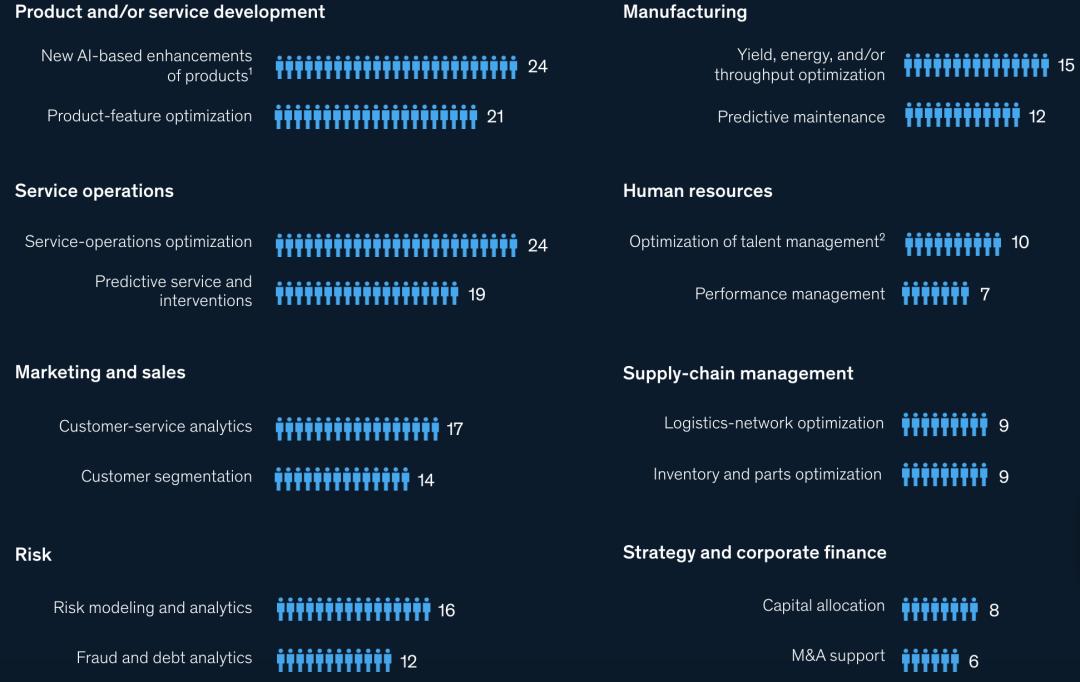
As shown in the figure, the AI utilization rate of product and service development, service operation and marketing remains high, among which product and service development is the department that uses AI the most, and the AI utilization rate of new product development based on artificial intelligence is 24%, and product function optimization is 21%.
In terms of the impact of AI, more than two-thirds of the respondents said that using AI can bring revenue growth through functions such as inventory and parts optimization, pricing and promotion, customer service analysis, sales and demand; More than half of the enterprises said that they can use AI to reduce costs, mainly in talent management, customer service center automation, warehouse automation and so on.
In addition, the survey results show that some companies using AI are seeing value added at the enterprise level. 22% of the respondents said that in 2019, more than 5% of the earnings before interest and tax in their organizations were attributed to the use of artificial intelligence, and 48% of the respondents said that the proportion was less than 5%.
It is worth noting that most companies use AI to increase their income, but the cost reduction is not common. The following figure shows the revenue growth brought by enterprises using AI in 2018 and 2019 (unit:%):
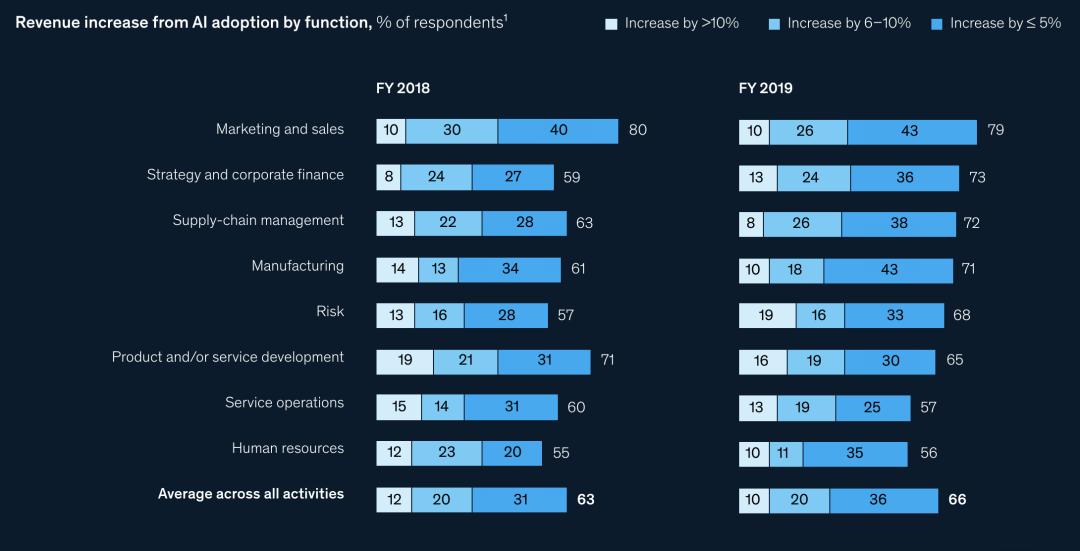
As shown in the figure, among the three departments of marketing, strategy and corporate finance, and supply chain management, AI has the greatest impact on revenue.
This year, McKinsey asked about the use of deep learning for the first time, and found that only 16% of the respondents said that they had introduced deep learning into the pilot stage, mainly in the high-tech and telecommunications industries. In these two industries, 30% of the respondents said that they had embedded deep learning capabilities.
Michael Chui, a partner of McKinsey Global Institute, commented on the above information, "The method of using income to measure where AI can bring value to enterprises still applies. We will see more and more companies using AI to increase revenue rather than reduce costs-not because AI can’t reduce costs. "
two
How can enterprises get more value from AI?
In the practice of AI deployment, there are always some companies that have better effects than others, and the report calls them "high-performance companies".
So what are the advantages of companies that see the greatest value from the use of AI (think that 20% or more of earnings before interest and tax within the enterprise in 2019 can be attributed to the use of AI) compared with other companies? The report lists the following points:
Higher annual growth rate: The research results show that the companies that get more earnings before interest and tax contribution from AI have better annual growth rate than other companies. Respondents of high-performance companies are almost twice as likely as others to report a 10% or more increase in EBIT in 2019.
Better overall leadership: These companies have more efficient top management and are more likely to have an active and capable leader.
Higher investment in technology: Compared with their peers, they have invested more in AI and are more likely to increase their investment in AI in the next three years. Moreover, compared with buying third-party solutions, high-performance companies often have the ability to develop their own AI solutions and hire more relevant talents. And has established a standardized end-to-end platform for AI-related data science, data engineering and application development.
At the same time, McKinsey also focused on the practice of enterprises deploying AI this year to judge which practices can make enterprises get more value from AI. The number of enterprises concerned this year is about twice that of the past.
These practices are usually divided into six categories: strategy; Talent and leadership; Methods; Tools and technologies; Data; AI deployment.
As can be seen from the following table, taking "strategy" as an example, there are still some differences between high-performance enterprises and other enterprises. For example, in the evaluation standard that "the whole organization consistently adheres to the implementation process and is regarded as the key to obtaining value from artificial intelligence", the success rate of high-performance enterprises is 55%, while that of other enterprises is 29%.
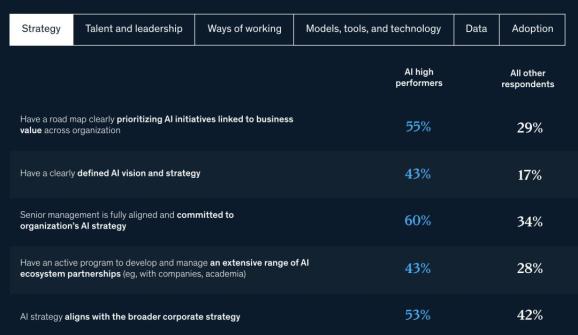
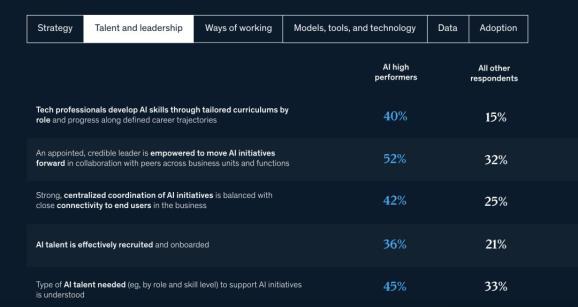
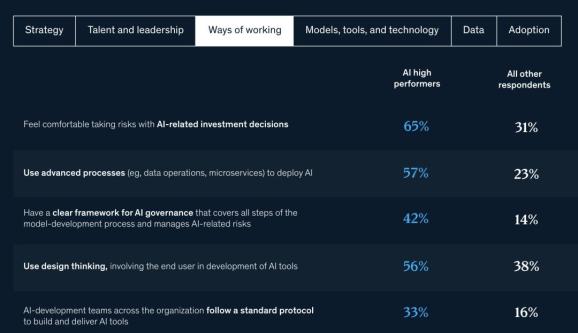
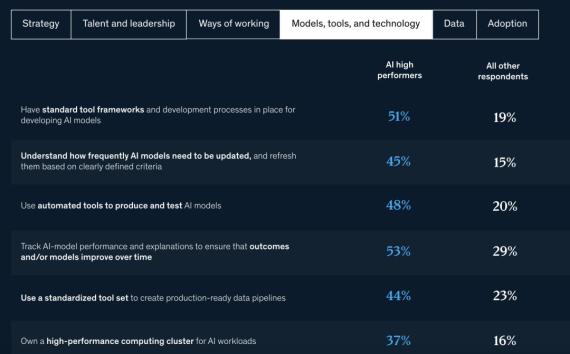
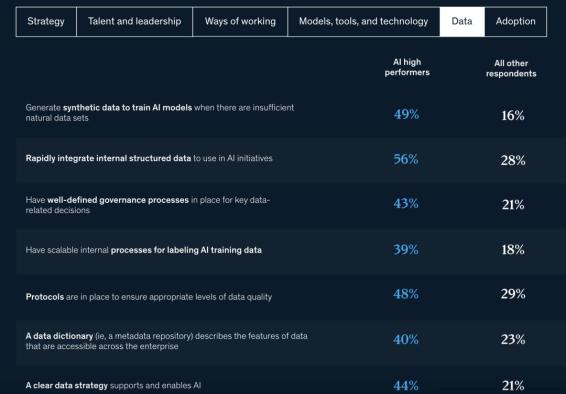
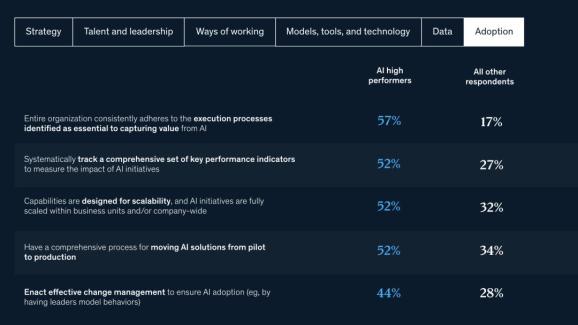
Swipe left and right to see more
"We found that companies with better performance often develop or deeply customize their artificial intelligence capabilities from within. Many executives now realize that AI usually works closely with business teams to meet real business needs and realize real value creation. Because, we see more and more enterprises training AI talents internally and launching training programs to improve the overall ability of the organization. " Bryce Hall, co-partner of McKinsey, commented on this.
Company executives who have made progress in the application of artificial intelligence also said in an interview with McKinsey that many leading practices are very important.
The head of analysis and insight of a global pharmaceutical company said, "We are investing heavily in talent training. If you have thousands of employees, you must consider how to make the whole workforce move forward. Investment has two directions: first, cooperate with a leading technology company to improve the data and artificial intelligence skills of employees; Second, a special course to improve the skills of senior managers and their understanding of artificial intelligence. "
three
Neglected AI risk perception
With the deepening of practice, the risks of AI have gradually emerged. However, the survey results show that only a few companies recognize the risks of AI, and fewer companies want to reduce the risks.
In terms of risk perception, most enterprises believe that network security, legal provisions and mode interpretability are AI-related risks, among which national security and personal safety have received more attention.
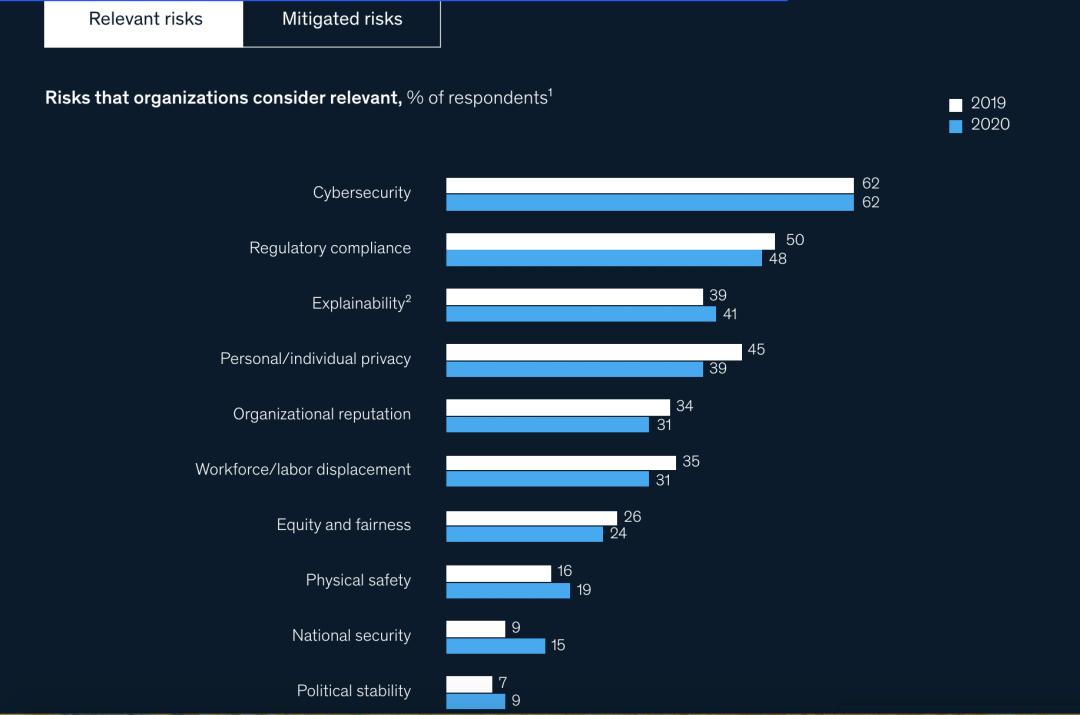
As the figure shows, network security is still the only risk that most interviewees consider relevant.
The situation of risk management is similar, but it is worth noting that more and more enterprises are beginning to realize and solve the problem of "model interpretability".
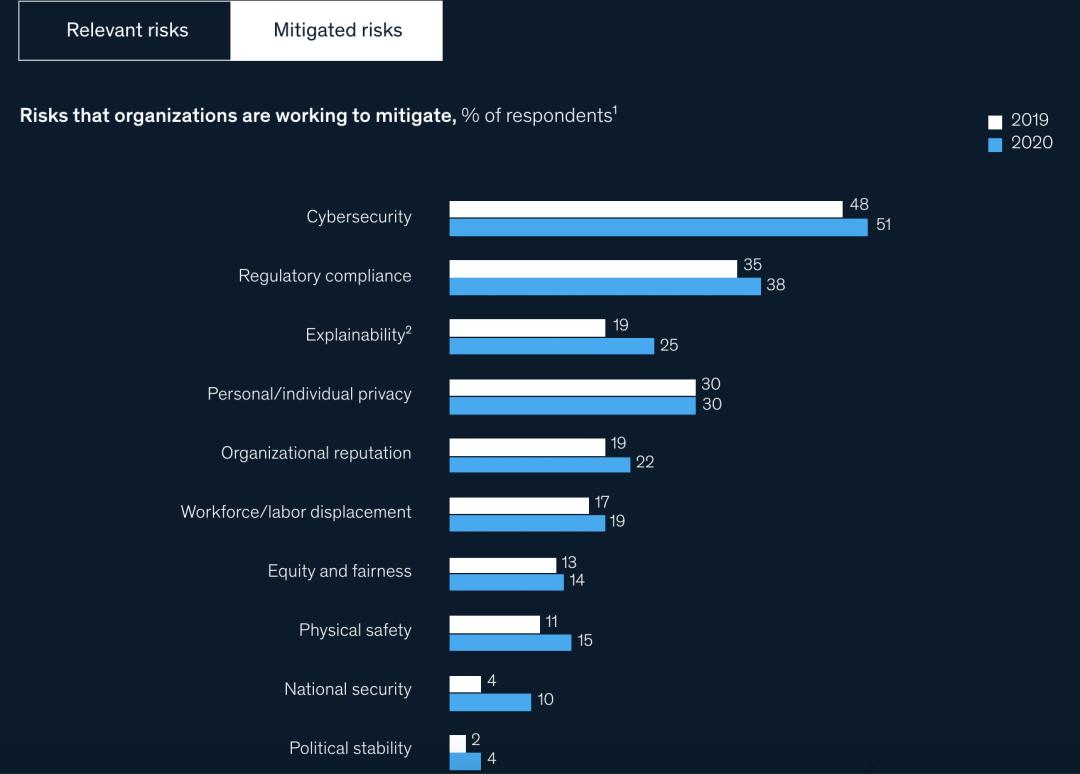
Roger Burkhardt, a partner in new york, said, "Due to the lack of interpretability, that is, people’s understanding of risks has improved.
Health care and financial services industries have the highest risk awareness due to stricter supervision, in addition, high-tech, commercial, legal and professional services industries are also in the leading position in risk awareness.
But overall, the results are still worrying. Although some risks, such as personal safety, are only applicable to specific industries, it is difficult to understand why many common risks have not been recognized by more respondents.
For example, fairness should be one of the concerns of any enterprise in any industry. What is particularly surprising is that people are concerned about racial prejudice and other discriminatory treatments (such as age discrimination in job advertisements on social media), but they have not paid attention to and alleviated the prejudice that AI may produce. "
Lack of model interpretability is a risk in almost every industry, especially in the fields of health care and finance. However, in addition to its own risks, interpretability may also bring another risk: lack of AI applications, leading to wasted investment and falling behind competitors. "
Some enterprises have also made targeted measures. In an interview with McKinsey, the director of artificial intelligence transformation of a global material manufacturer pointed out that it is almost impossible for front-line workers to adopt AI without an interpretable model. Workers need to be able to trust AI’s judgment, not only to take the most effective action, but also for their personal safety.
When AI suggests running a potentially dangerous heavy equipment in some way, the staff need to be sure that the reasons behind the decision are reliable and safe. This material manufacturer uses the simplest and most transparent model to realize interpretability, which to a great extent makes workers confident in using new artificial intelligence applications.
The company also improved its operation through AI and analysis measures, which increased its profit before interest, tax, depreciation and amortization by 15%.
four
Epidemic situation accelerates AI application
Although epidemic prevention measures have brought economic challenges to many companies, those companies that can see the greatest value of AI are still increasing their technical investment. According to the report, most respondents from high-performance companies said that their investment in AI has increased, mainly in the automobile, assembly, health care services, pharmaceuticals and medical products industries.
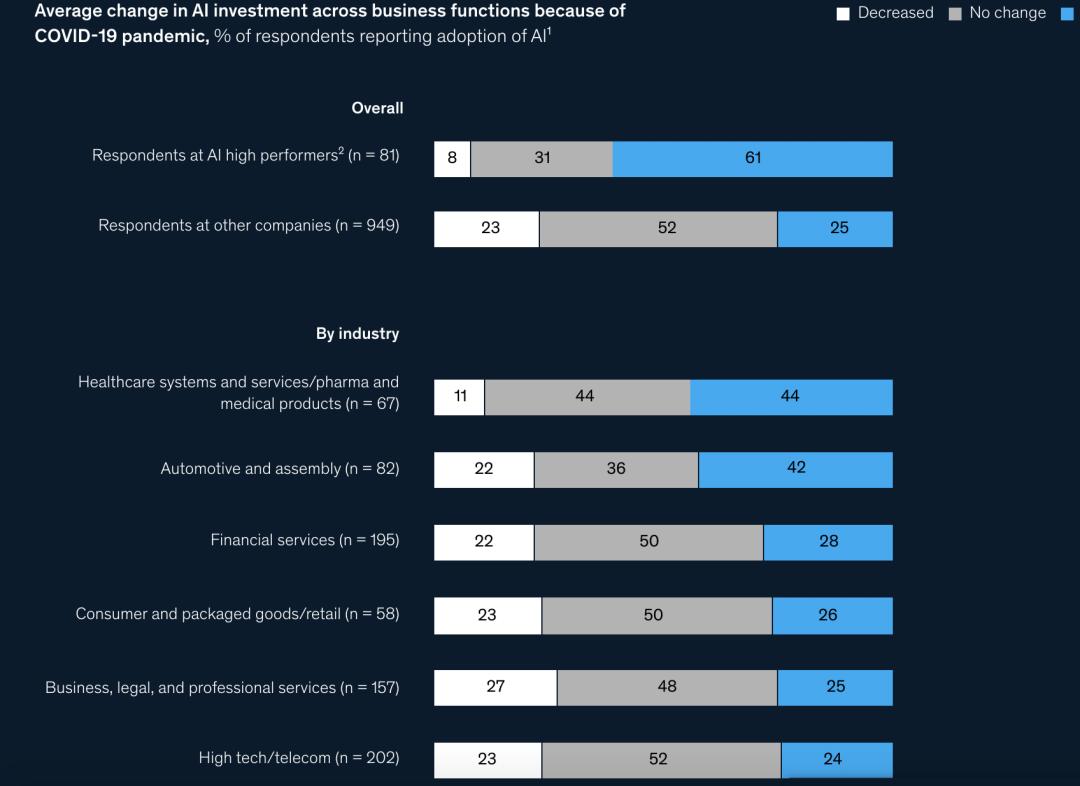
As shown in the figure, during the epidemic, most outstanding companies increased their investment in AI, but the changes in different industries were different.
However, the more AI technology is deployed, the more you can feel its risks. Many high-performance companies say that their AI models are particularly fragile in marketing, sales, product development and service operation.

As shown in the figure, since the epidemic, the deployment of AI model in marketing and sales business has not performed well.
There are also some companies that have used AI to find new growth points under the pressure of the epidemic. As Nicolaus Henke, senior partner of McKinsey, said, "The epidemic has rapidly shifted consumers and businesses to digital channels. During the epidemic, enterprises in various industries expanded artificial intelligence much faster than expected. Many enterprises cooperate with their analysis teams to update demand patterns, reconsider supply chains, build scenario plans around resource requirements, and realize automation in factories and other industrial environments.
For example, a global pharmaceutical company linked multiple epidemic scenarios, established a view of product supply and demand by country, and integrated it into its regular financial and operational planning process. In some cases, the short-term analysis solutions of enterprises are not very accurate, but executives realize that these solutions are’ good enough’ compared with other methods.
Many enterprises have turned to longer-term opportunities. For example, with more and more data from digital channels, AI-based system recommendation can provide better customer experience, more personalized content and automated digital customer service.
Therefore, it is not surprising that the epidemic has prompted people to increase their investment in AI. However, companies that do not perform well in the AI field obviously do not invest so much money, and there is a risk of further falling behind the leaders. "
This survey also found many companies that invested in AI in the epidemic. For example, the epidemic has accelerated the integration of online and offline service data of banks. Based on these data, a global bank launched an intelligent chat robot to provide customers with contactless and more targeted services.
"The epidemic has become an accelerator and catalyst for AI application and digital transformation. For those enterprises that have deployed AI in advance, the epidemic can promote the faster, more accurate and more reliable landing of AI projects. In the future, enterprises will become more and more dependent on the capabilities brought by AI." An analyst of a large pharmaceutical company said in an interview with McKinsey.
Reference link:
https://www.mckinsey.com/business-functions/mckinsey-analytics/our-insights/global-survey-the-state-of-ai-in-2020
The machine can provide high-quality information, research insights, databases, technology supplier research and docking services for industries in various fields that are undergoing digital transformation and intelligent upgrading, and help them better understand and apply technology. The industrial side can contact us if there is any demand for the above services.
zhaoyunfeng@jiqizhixin.com
Original title: "The latest survey of McKinsey enterprise AI status: only 16% introduced deep learning; Most of them have no awareness of AI risks. "
Read the original text